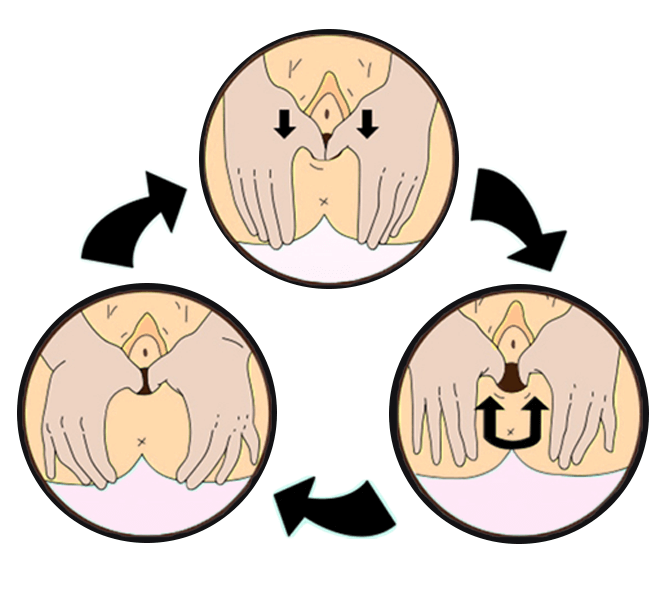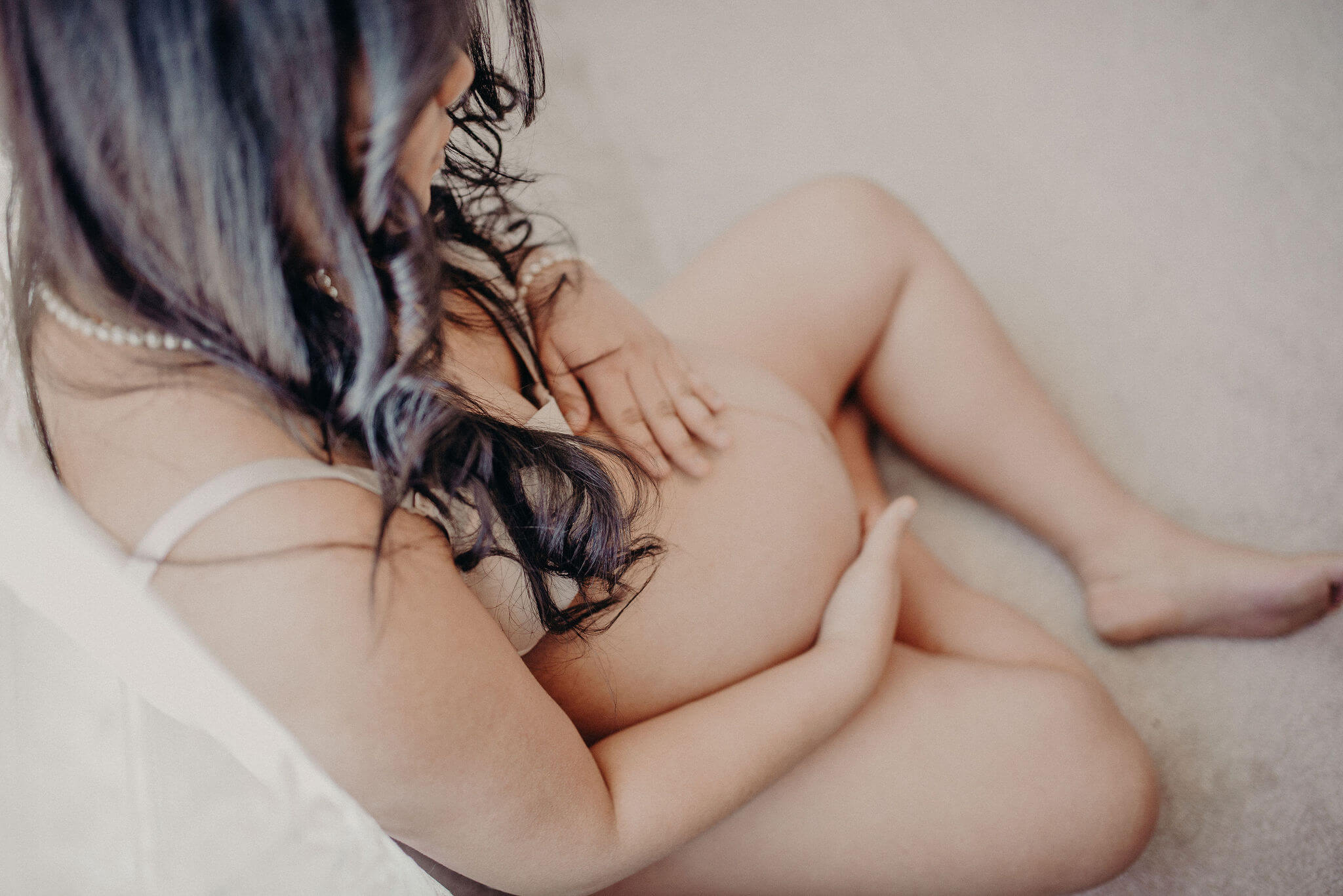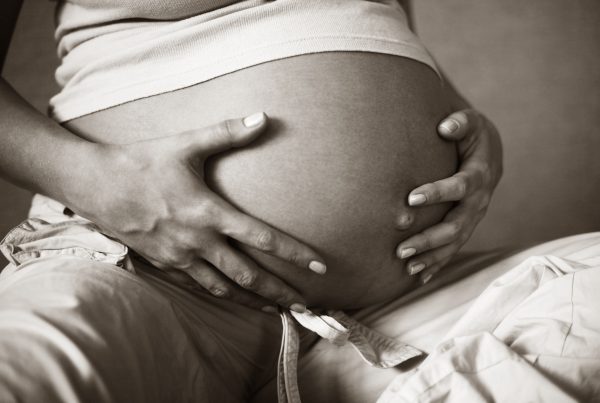Since your baby’s head needs to squeeze through a relatively small opening you may be wondering if there is any way your can prepare your ‘down there’ for childbirth.
Perineal Massage is the answer!
Perineal massage is gentle, manual stretching of your perineum to prepare the muscles and skin between your birth opening and anus for the birth of your baby. The goal is to reduce the risk of tearing and scarring or episiotomy when you birth.
Peri-what-now?
For those who aren’t aware, the muscle and tissue that lies between the birth opening and anus is called the perineum. It is an area between 2 and 5 centimetres long and connects with the muscles in the lower pelvis (the pelvic floor).
Being a collection of muscle and tissues it is fairly thick and tight, especially if you have been vigilant with your Kegels and is slightly less elastic than the tissue of the birth opening.
When giving birth, the perineum is the part that stretches to allow the birth opening to accommodate baby as they come into the world. It is also the area that may tear during birth, or that is cut with an episiotomy.
Why am I massaging that?
Roughly between 4 and 8 out of every 10 people who birth physiologically will experience some degree of tearing in their perineum, and about two-thirds of these will require stitches.
Utilising perineal massage regularly from 34 weeks gestation can reduce tissue damage from tearing and the risk of episiotomy. Thirty-four weeks is the magic number because this is the time that your body produces a final surge of the hormone Relaxin which softens and lengthens your tissues in readiness for birth. Massaging the area increases the blood flow to the tissue and muscles keeping them healthy and ready to do the hard work ahead.
Stretching the tissues at the entrance of the birth opening also helps with recognising and welcoming the stretching sensation as baby moves down the birth path. Being able to recognise this feeling will help you remain calm and relaxed and get in the zone as the stretching happens. It is also a reminder to practice your deepening techniques if you are hypnobirthing.
Ok! So how do I do it?
It is important to begin by setting a clear intention. For example “I am softening and stretching for birth” or “I am connecting with my perineum”. Setting this intention will help your mind and body process that this activity is not for sex, it is purely for the intention of readying for birth. Sex can be for another time.
STEP 1: WASH YOUR HANDS
Each and every massage session should begin with impeccably clean hands with neatly trimmed nails to ensure you don’t introduce any germs or cause any damage to the delicate tissues.
STEP 2: GET COMFY
Find a place where you feel comfortable, private and safe. Maybe your bed, the couch, shower or toilet will be that place for you. Being 34 weeks plus pregnant it may be difficult to reach around your belly so reclining on pillows or standing with one foot on a stool may be helpful. If you are still struggling, you may choose to ask your partner to help.
It might be nice to set a lovely relaxing atmosphere too, maybe something similar to that which you intend to create for your birth…candles, music, aromatherapy.
STEP 3: BEGIN – GENTLY
With well-lubricated hands, begin by placing one or both thumbs about 2 – 5 centimetres inside your birth opening. Consider using a mirror the first few times to help your awareness of the area and to ensure you are massaging the right areas.
Press your thumbs downwards along the back wall of the birth opening towards your anus. Don’t press too hard but you do want to apply enough pressure to feel a stretch or some tingling.
Note: If you choose to get your partner to assist with your massage remember communication is key. You will need to direct them as to when they need to apply more pressure or less pressure depending on what you are feeling. Also remind them that slow and steady is the way to go, as you are trying to reach a relaxed state. Cease massage immediately if there is any pain or discomfort beyond a stretching, tingling sensation.
STEP 4: STRETCH
Keep your thumbs in this stretched position for 1 or 2 minutes. Then move to another position and repeat.
If you consider the birth opening to be a clock face, you want to be stretching at points from 3 o’clock to 9 o’clock. Another option is to move from the 3 o’clock to 9 o’clock positions in a sweeping motion stretching as you go.
Remember whichever way you do it you are mostly targeting the tissues on the inside of the opening but you should feel the stretching sensation on both the inside and outside of the opening.
STEP 5: RELAX
Try to relax as much as possible during the massage, both your mind and your body. This will build some positive associations between mind and body when you feel the stretching sensation during birth.
STEP 6: HONOUR
This is a very intimate space to massage. It is important to be gentle, compassionate and accepting. Your intention and presence with the sensations are the keys to embodying the benefits of your massage.
Afterwards, you may feel sensitive, fragile or emotional OR you may feel free, joyful or sensual. Or you may feel something else! All is perfect and there is no right or wrong. Know that you have taken the steps to soften for birth and deeply connect and honour your inner birthing wisdom.
STEP 7: REPEAT
Repeat this every few days increasing the time you spend connecting with your body and massaging to 5-10 minutes.
Will it make a difference?
Regular perineal massage is a good tool to add to your birthing toolbox.
While it doesn’t guarantee that you won’t tear or need an episiotomy it can help you prepare for your birth by familiarising you with the sensations you may feel as baby makes its way down the birth path.
Are there times I shouldn’t massage?
Yes! You should not perform this massage technique:
Prior to 34 weeks gestation
If you have placenta praevia or any other condition where there is bleeding from the birth opening in the second half of pregnancy
If you suffer from any infections in the area including thrush or herpes.
How do I continue to look after my Perineum after birth?
You shouldn’t (and probably won’t want to) continue perineal massage after you have given birth.
You should, however, try a few gentle pelvic floor contractions (Kegels) as soon after birth as you feel comfortable. This is just a quick check to see if you can feel your birth opening contract. Don’t overdo it, but a few gentle Kegels a few times a day will help to increase blood flow back to the area and help with healing.
One of the most important follow-ups after birth is a visit to a Pelvic Floor Physiotherapist at around 6-8 weeks postpartum. They are my go-to for a thorough evaluation of any residual pain, dysfunction or incontinence.
A little help from the right person can go a long way in thanking your perineum for all of its hard work!

How to Do Perineal Massage





